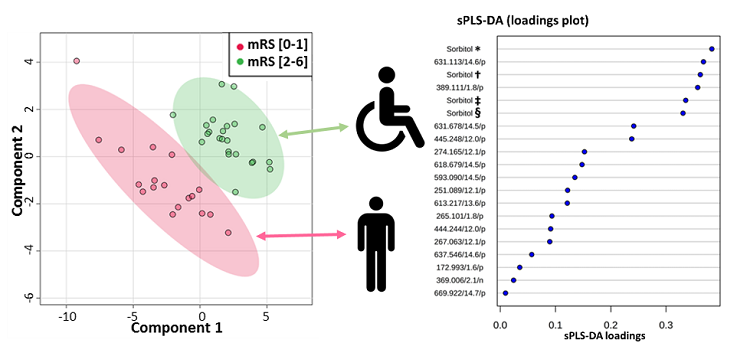Stroke is a frequent vascular pathology that causes disability and death. Curative treatment consists of restoring blood flow in the occluded artery as quickly as possible to limit the consequences of a stroke. In recent years, mechanical thrombectomy, in combination with fibrinolytic treatment, has made it possible to achieve very significant recanalization rates. However, one out of every two patients treated with this technique, will not recover his autonomy. A strategy providing neuroprotection from the acute phase of the stroke to arterial recanalization has yet to be developed to preserve brain tissue.
Hyperglycemia on admission to hospital is associated with a poor functional prognosis, despite the success of subsequent thrombectomy. This high level of glucose, which is the main fuel of the brain, has a deleterious effect called the "glucose paradox" whose underlying molecular mechanisms are not precisely known. A neuroprotective strategy based on glycemic control with insulin therapy in the acute phase after patient admission did not result in clinical improvement. Considering that the analysis of the role of glucose was based solely on its measurement at admission, the TIRO team carried out a metabolomic analysis of the cerebral thrombus in an attempt to obtain information in an original way from the cells trapped in the clot at the time of vascular occlusion.
The results obtained by machine learning (sparse Partial Least Squares Discriminant Analysis or sPLS-DA) revealed the importance of sorbitol level in the discrimination of both groups of patients, making this compound a metabolomic signature highly correlated with functional prognosis. Corroborated by other findings indicating that a high level of sorbitol is a persistent marker of hyperglycemia, the sorbitol level observed in this study is indeed a marker of blood glucose levels in thrombus-trapped cells. The results also show a joint variation in glucose and sorbitol levels and make it possible to establish, for the first time, a strong correlation between hyperglycemia during arterial occlusion and good functional prognosis (Figure).

The metabolomic signature of cerebral thrombi is correlated with functional prognosis. sPLS-DA analysis based on untargeted metabolomic data of cerebral thrombi discriminated stroke patients according to their clinical outcomes (red and green dots represent respectively, patients with mRS (0–1) and mRS (2–6) at 3 months). The score plot (left graph) is represented with a confidence ellipse of 95%. Loading plot (right graph) of top 20 features selected on the first component of the sPLS-DA model revealed adducts and isotopes related to high plasmatic glucose as the main contributors. © T.Pourcher / CEA
Thanks to this original observation, it was possible to illustrate the expected beneficial effect of glucose during a stroke. This result will need to be confirmed by larger clinical studies, but already suggests the importance of targeting acute neuroprotection from the pre-hospital phase.
The TIRO team is continuing its collaboration with Dr Laurent Suissa on this theme of neuroprotection in the acute phase: one possible approach would be to administer oral ketone bodies, accessory fuels for the brain, to alleviate the energy crisis linked to occlusion.
The pharmacokinetics and cerebral pharmacodynamics of an oral ketone ester (2nd publication), studied by metabolomics, make this molecule a potential neuroprotective candidate in the acute phase of cerebral ischemia. To be continued...
Contact : Thierry Pourcher